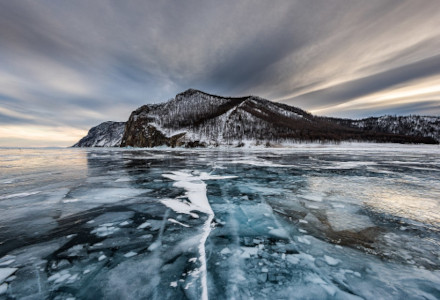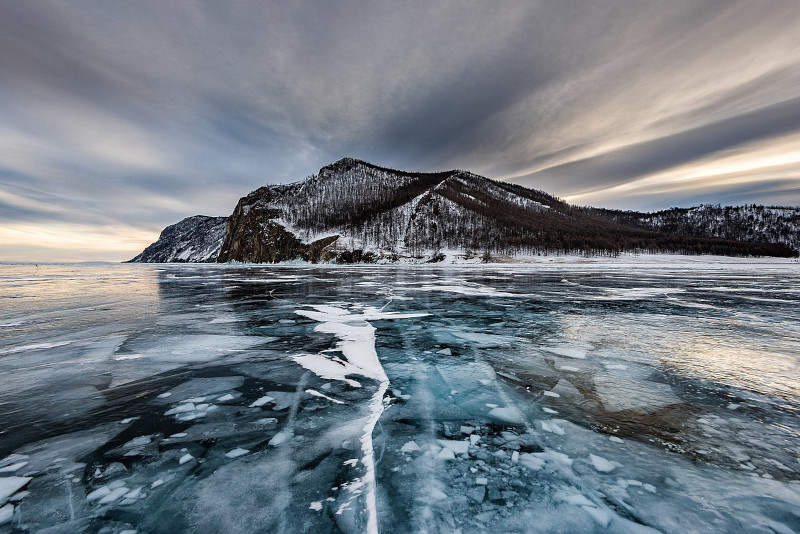Lake Baikal Facts
- This amazing body of freshwater, almost unbelievably huge in dimensions, holds the deceptively simple english name of Lake Baikal. In the language of the region of the world in which it formed, however, this natural marvel holds the name Oзеро Байкал.
- Archaeological evidence indicates that prehistoric humans knew of its existence long ago. They also apparently inhabited its region in the distant past. In more modern times, though, it only came to the attention of daring explorers in the 17th century.
- The first recorded explorer to reach its incredibly remote shores was the Russian explorer, Kurbat Ivanov. This historically important discovery he accomplished in the year 1643. This occurred due to Russian expansion into the region from 1628 – 1658.
- This mnd-blowing creation of geological processes also holds not one, but several claims to fame. That’s partly due to the fact that it ranks as the largest single freshwater lake on earth, by volume. It’s also the deepest and the oldest known lake in the world.
- Understandably, the stunning Lake Baikal garnered the attention of UNESCO. Due to its extreme statistics and ecological importance in the region, the organization named it a World Heritage Site. The organization applied this important status in 1996.
- This status helps to provide the formation a measure of protection from the depredations of man. Its sheer remoteness, also provides it with a great degree of protection. It’s nevertheless threatened by climate change, like the rest of the earth.
Related Articles
Lake Baikal Physical Description
Quotiing numbers alone can’t adequately convey the sheer scale of the breathtaking Lake Baikal. Yet, that’s the only meauring stick we humans have to attempt to describe places such as this. So, herein we therefore present to you the statistics of this masterpiece.
The total surface area of this incredible formation boggles the mind. That’s because it measures approximately 12,248 sq mi (31,722 sq km). That, however, as hard as it may be to believe only qualifies it as the seventh largest lake in the world, by surface area!
Its volume, though, truly staggers the mind. This holds true due to the fact that it contains roughly 5,670 cubic mi (23,615 cubic km) of water! That represents a staggering 23% of the surface freshwater on earth! It’s also more than the Great Lakes combined!
The wonders of this creation of time and natural processes don’t simply stop there, however. That’s because it also boasts the greatest known depth of any body of freshwater on the planet. More precisely, its deepest point measures 5,387 ft (1,642 m).
Not content with these record setting measurements, though, Lake Baikal also holds the top position on one more list. This marvelous body of water also remains the oldest known lake, with an age of between 25 – 30 million years, in addition to being among the clearest.
Lake Baikal Location, Formation, and Ecology
The astounding beauty of Lake Baikal formed in a region of the globe that many people would not think of as holding incredible geological wonders. That’s due to the fact that it formed in an area that most people would consider among the most desolate on earth.
In point of fact, this natural marvel formed in a remote part of the continent of Asia. More precisely still, the breathtaking rift lake lies in the southern portion of the geographical region now known as Siberia. This area forms part of the country of Russia.
The visually impressive lake formed in what’s known as a rift valley. In its case, the formation was created due to the actions of the Baikal Rift Zone. In this series of continental rifts, the crust of the earth continues to be slowly yet inexorably pulled apart.
That same geological process also created a surreal landscape surrounding the lake itself, providing a truly astonishing visual effect. That’s because the lake’s almost entirely surrounded by several mountain ranges. It’s also fed by an incredible 330 rivers.
Despite what many consider to be a harsh environment, Lake Baikal boasts an extraordinarily rich biodiversity. Researchers know of over 2,500 species of animals, and more than 1,000 species of plants thriving in the area, with most being endemic.
Much of the native flora consists of various aquatic species. A wide variety of mammals also make the area home, such as bears, wolves, foxes, and reindeer. Meanwhile, a total of 236 confirmed species of birds, and aabout 65 species of fish also call the lake home.
Features Sharing Its Region
Check out our other articles on 3 Stunning Sea Lions, Hemlock Looper, Dune du Pilat, Gray Fox, Tree Heather, Pesquet’s Parrot, Velvet Belly lanternshark, Texas Blind Salamander


